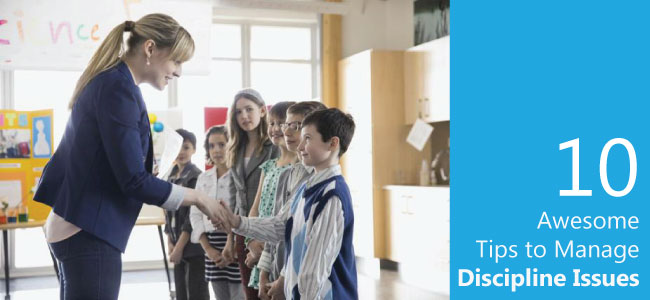Teaching a number of children with different attitudes, behaviour and attention spans can be a challenging task. Bad behavior is not something a teacher should tolerate in a classroom. You cannot ignore it or it will get worse. It is crucial to teach students to manage their own behavior. Understanding the root cause of the child‘s behaviour is essential. Basic models in understanding child behaviour includes:
Must Read:
• Biological, where children’s behavior will be influenced by their environment
• Behavioral, where behavior can be modified through classical or operant conditioning
• Cognitive, the approach that helps the child judge and reason effectively and have a perception of their surroundings
• Systemic that targets the individual‘s behavior within the family, friends, school, classmates and community
• Psychodynamic that focus on understanding and intervening by unravelling past conscious and unconscious experiences
Effective classroom management strategies should be implemented to run a well-disciplined classroom. Behaviour management can promote a positive and caring classroom community that encourages student learning, positive peer and teacher relationships and self-motivation.
Effective Strategies to Check Out
An effective classroom management will help to develop a quality relationship between the teacher and the students in the classroom. Certain classroom management strategies can help to change student’s attitude gradually.
1. Teach those Routines and Rules
First, create the rules and the routines that the class agree. Next step is teaching them. Explain the created rules in a clear, brief language. Students should also be taught to use those rules in different special areas such as the lunchroom, hallway, school bus, or playground. It is ideal to create routines and rules in the beginning of the school year and also shared with parents. It should also be reviewed frequently throughout the year. Most students learn routines and procedures quickly. The teacher has to periodically review the routine and reteach it.
2. Be fair, but Consistent in Class
A teacher needs to be fair with the students, but at the same time consistent. Students should know that if they do something wrong, what the consequence is going to be. They should be aware that there are consequences that follow from the way they behave. Consequences may include formal punishments. Even though punishments are last option, it is important to deal with serious misbehavior.
You May Also Like:
3. Arrange Classroom Meetings
A positive classroom atmosphere can be promoted by conducting classroom meetings on a regular basis. Such meeting can encourage effective communication between the teacher and the students. This also provides an opportunity for the teacher to involve special students in all classroom activities. Certain ground rules should also be created for the meeting such as students should help each other, they should show mutual respect, and only one should speak at a time.
4. With-It-Ness
With-it-ness refers to the teacher’s ability to know what is going within the class or among students, even without watching a student or group of students. It is less likely that students will misbehave if they know their teacher notices every little thing going on in the classroom. It is essential that teachers should use their peripheral vision. This helps them to indirectly monitor what is happening in all areas of the class. Continuously scanning the room to see what is going on. Hope you remember your school age where you assume that good teachers have eyes in the back of their heads.
Social stories can also be used to teach students new social skills, routines, behavior, and transitions. Encourage students to praise each other by clapping, cheering or even doing something positive. It creates a positive and fun classroom environment. Effective classroom management strategies can also increase the engagement of all students rather than just a few paying attention and few responding to teacher’s questions.









